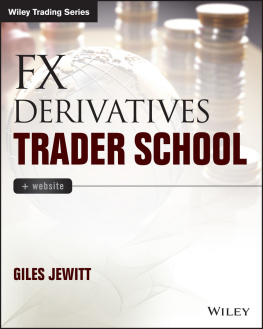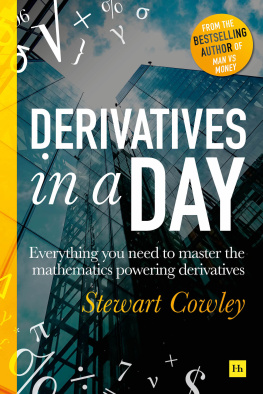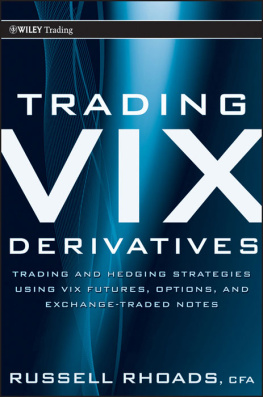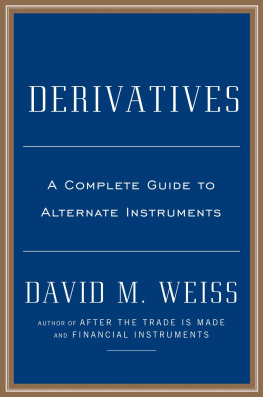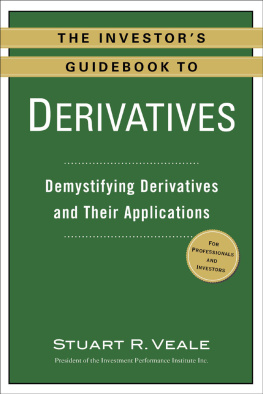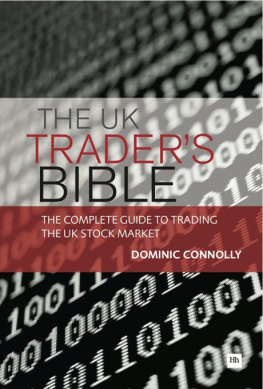Jewitt - FX Derivatives Trader School
Here you can read online Jewitt - FX Derivatives Trader School full text of the book (entire story) in english for free. Download pdf and epub, get meaning, cover and reviews about this ebook. year: 2015, publisher: John Wiley & Sons, Incorporated, genre: Business. Description of the work, (preface) as well as reviews are available. Best literature library LitArk.com created for fans of good reading and offers a wide selection of genres:
Romance novel
Science fiction
Adventure
Detective
Science
History
Home and family
Prose
Art
Politics
Computer
Non-fiction
Religion
Business
Children
Humor
Choose a favorite category and find really read worthwhile books. Enjoy immersion in the world of imagination, feel the emotions of the characters or learn something new for yourself, make an fascinating discovery.
- Book:FX Derivatives Trader School
- Author:
- Publisher:John Wiley & Sons, Incorporated
- Genre:
- Year:2015
- Rating:5 / 5
- Favourites:Add to favourites
- Your mark:
- 100
- 1
- 2
- 3
- 4
- 5
FX Derivatives Trader School: summary, description and annotation
We offer to read an annotation, description, summary or preface (depends on what the author of the book "FX Derivatives Trader School" wrote himself). If you haven't found the necessary information about the book — write in the comments, we will try to find it.
FX Derivatives Trader School — read online for free the complete book (whole text) full work
Below is the text of the book, divided by pages. System saving the place of the last page read, allows you to conveniently read the book "FX Derivatives Trader School" online for free, without having to search again every time where you left off. Put a bookmark, and you can go to the page where you finished reading at any time.
Font size:
Interval:
Bookmark:

The Wiley Trading series features books by traders who have survived the market's ever changing temperament and have prosperedsome by reinventing systems, others by getting back to basics. Whether a novice trader, professional, or somewhere in-between, these books will provide the advice and strategies needed to prosper today and well into the future. For more on this series, visit our Web site at www.WileyTrading.com.
Founded in 1807, John Wiley & Sons is the oldest independent publishing company in the United States. With offices in North America, Europe, Australia, and Asia, Wiley is globally committed to developing and marketing print and electronic products and services for our customers' professional and personal knowledge and understanding.
Copyright 2015 by Giles Jewitt. All rights reserved.
Published by John Wiley & Sons, Inc., Hoboken, New Jersey.
Published simultaneously in Canada.
No part of this publication may be reproduced, stored in a retrieval system, or transmitted in any form or by any means, electronic, mechanical, photocopying, recording, scanning, or otherwise, except as permitted under Section 107 or 108 of the 1976 United States Copyright Act, without either the prior written permission of the Publisher, or authorization through payment of the appropriate per-copy fee to the Copyright Clearance Center, Inc., 222 Rosewood Drive, Danvers, MA 01923, (978) 750-8400, fax (978) 646-8600, or on the Web at www.copyright.com. Requests to the Publisher for permission should be addressed to the Permissions Department, John Wiley & Sons, Inc., 111 River Street, Hoboken, NJ 07030, (201) 748-6011, fax (201) 748-6008, or online at http://www.wiley.com/go/permissions.
Limit of Liability/Disclaimer of Warranty: While the publisher and author have used their best efforts in preparing this book, they make no representations or warranties with respect to the accuracy or completeness of the contents of this book and specifically disclaim any implied warranties of merchantability or fitness for a particular purpose. No warranty may be created or extended by sales representatives or written sales materials. The advice and strategies contained herein may not be suitable for your situation. You should consult with a professional where appropriate. Neither the publisher nor author shall be liable for any loss of profit or any other commercial damages, including but not limited to special, incidental, consequential, or other damages.
For general information on our other products and services or for technical support, please contact our Customer Care Department within the United States at (800) 762-2974, outside the United States at (317) 572-3993 or fax (317) 572-4002.
Wiley publishes in a variety of print and electronic formats and by print-on-demand. Some material included with standard print versions of this book may not be included in e-books or in print-on-demand. If this book refers to media such as a CD or DVD that is not included in the version you purchased, you may download this material at http://booksupport.wiley.com. For more information about Wiley products, visit www.wiley.com.
Library of Congress Cataloging-in-Publication Data:
ISBN 9781118967454 (Paperback)
ISBN 9781119096610 (ePDF)
ISBN 9781119096474 (ePub)
Cover image: Business World iStock.com/ktsimage; abstract background iStock.com/PiexelEmbargo
Cover design: Wiley
For my wife and daughters: Laura, Rosie, and Emily.
In 2004 I started on an FX derivatives trading desk as a graduate. I wrote down everything I learned: how markets worked, how FX derivatives contracts were risk-managed, how to quote prices, how Greek exposures evolve over time, how different pricing models work, and so on. This book is a summary of that knowledge, filtered through a decade of trading experience across the full range of FX derivatives products.
In 2011 I started sending out monthly Trader School e-mails to traders on the desk, covering a wide range of topics. The e-mails were particularly popular with new joiners and support functions because they gave an accessible view of derivatives trading that did not exist elsewhere. This book collects together and expands upon those e-mails.
Part I covers the basics of FX derivatives trading. This is material I wish I'd had access to when originally applying for jobs on derivatives trading desks. covers exotic FX derivatives trading, starting with the most basic products and slowly increasing the complexity up to advanced volatility and multi-asset products. This material will mostly be useful to junior traders or traders looking to build or refresh their knowledge in a particular area.
Fundamentally, the aim of the book is to explain derivatives trading from first principles in order to develop intuition about derivative risk rather than attempting to be state of the art. Within the text, experienced quant traders will find many statements that are not entirely true, but are true the vast majority of the time. Endlessly caveating each statement would make the text interminable.
Traders can only be successful if they have a good understanding of the framework in which they operate. Importantly though, for derivatives traders this is not the same as fully understanding derivative mathematics. Therefore the mathematics is kept to an accessible advanced high school level throughout. Some mathematical rigor is lost as a result of this, but for traders that is a price worth paying.
Also in the interests of clarity, some other important considerations are largely ignored within the analysis, most notably, credit risk (i.e., the risk of a counterparty defaulting on money owed) and interest rates (i.e., how interest rate markets work in practice). Derivative product analysis is the primary concern here and this is cleaner if those issues are ignored or simplified.
Regulations and technology are causing significant changes within the FX derivatives market structure. The most important changes are increasing electronic execution, increasing electronic market data, more visibility on transactions occurring in the market, and less clear distinctions between banks and their clients. These changes will have profound and lasting effects on the market. However, the ideas and techniques explored within the book hold true no matter how the market structure changes.
Finally, and most importantly, if you are a student or new joiner on a derivatives trading desk: Do the practicals. I can guarantee that if you complete the practicals, you will hit the ground running when you join a derivatives trading desk. Do them. Do them all. Do them all in order. Do not download the spreadsheets from the companion website unless you are completely stuck. When you're trying to learn something, taking the easy option is never the right thing to do. The practicals require the ability to set up Excel VBA (Visual Basic for Applications) functions and subroutines. If you aren't familiar with this, there is plenty of material online that covers this in detail.
The very best of luck with your studies and careers,
Giles Jewitt, London, 2015.
Thanks are due to
those who taught me:
- Fred Boillereau
- Jeff Wang
- Mike Killen
- Rob Ross
- Hossein Zaimi
those who supported me in writing the book and helped make it happen:
- Howard Savery
- Caroline Prior
- Vincent Craignou
- Selene Chong
all colleagues who helped me with content, especially:
- Chris Potter
- Charlie Chamberlain
Font size:
Interval:
Bookmark:
Similar books «FX Derivatives Trader School»
Look at similar books to FX Derivatives Trader School. We have selected literature similar in name and meaning in the hope of providing readers with more options to find new, interesting, not yet read works.
Discussion, reviews of the book FX Derivatives Trader School and just readers' own opinions. Leave your comments, write what you think about the work, its meaning or the main characters. Specify what exactly you liked and what you didn't like, and why you think so.

